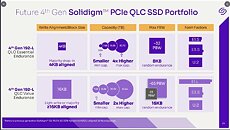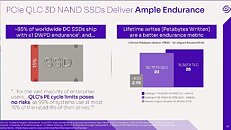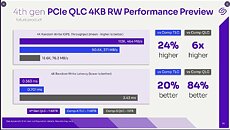TheLostSwede
News Editor
- Joined
- Nov 11, 2004
- Messages
- 18,472 (2.47/day)
- Location
- Sweden
| System Name | Overlord Mk MLI |
|---|---|
| Processor | AMD Ryzen 7 7800X3D |
| Motherboard | Gigabyte X670E Aorus Master |
| Cooling | Noctua NH-D15 SE with offsets |
| Memory | 32GB Team T-Create Expert DDR5 6000 MHz @ CL30-34-34-68 |
| Video Card(s) | Gainward GeForce RTX 4080 Phantom GS |
| Storage | 1TB Solidigm P44 Pro, 2 TB Corsair MP600 Pro, 2TB Kingston KC3000 |
| Display(s) | Acer XV272K LVbmiipruzx 4K@160Hz |
| Case | Fractal Design Torrent Compact |
| Audio Device(s) | Corsair Virtuoso SE |
| Power Supply | be quiet! Pure Power 12 M 850 W |
| Mouse | Logitech G502 Lightspeed |
| Keyboard | Corsair K70 Max |
| Software | Windows 10 Pro |
| Benchmark Scores | https://valid.x86.fr/yfsd9w |
Solidigm—the company that Intel sold its SSD business to—held a tech day last week where the company shared some details about its future roadmaps. The company appears to be focusing on 3D QLC NAND and its 192-layer product promises both larger drives, but also enhanced endurance for QLC NAND. For example, Solidigm's 30.72 TB SSD is promising a PBW of around 32 PB (Petabyte) endurance. This is using what the company calls QLC Essential Endurance NAND.
However, its QLC Value Endurance NAND is what will enable the 61.44 TB drive, which is said to offer around 65 PB write endurance, but it should be noted that this is at 16 KB aligned data or during other types of light data writes. Neither type of NAND is destined for consumer applications as of now, as Solidigm is only targeting E1, E3 and U.2 form factors. Regardless, this appears to be a huge step forward for 3D QLC NAND and Solidigm is hoping that its upcoming drives will be able to replace mechanical drives in the enterprise market space. On top of this, Solidigm also claims to offer better throughput and latency compared to its competitors, but we're still looking at SATA type level SSD performance for the IOPS. The first drives with the new 192-layer 3D QLC NAND are expected to be available sometime early next year.



View at TechPowerUp Main Site | Source
However, its QLC Value Endurance NAND is what will enable the 61.44 TB drive, which is said to offer around 65 PB write endurance, but it should be noted that this is at 16 KB aligned data or during other types of light data writes. Neither type of NAND is destined for consumer applications as of now, as Solidigm is only targeting E1, E3 and U.2 form factors. Regardless, this appears to be a huge step forward for 3D QLC NAND and Solidigm is hoping that its upcoming drives will be able to replace mechanical drives in the enterprise market space. On top of this, Solidigm also claims to offer better throughput and latency compared to its competitors, but we're still looking at SATA type level SSD performance for the IOPS. The first drives with the new 192-layer 3D QLC NAND are expected to be available sometime early next year.



View at TechPowerUp Main Site | Source




